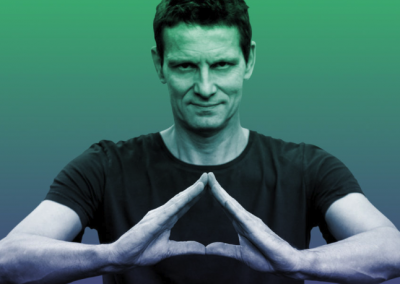#WAVEtalks – Peter Decuypere
Peter Decuypere is the founding father of I Love Techno and Fuse, and now also a best-selling author with We Love Events and Holy Trinity Events. He is well known for his fresh and daring view of marketing, and so fits in perfectly with our #WAVEtalks.
How does a brand add something to your fans’ experience?
Being a fan is important and means that a brand has won your heart. And this means that your brand’s values have to match your fan’s. Just take ‘Trump’ as an example of a brand. Some people would feel an attachment whilst others never would.
The essence of being a fan is heart-felt loyalty.
How do you ensure that someone feels loyal to your brand?
As a brand you first have to set out clear values associated with your product. What values do Mr or Mrs Apple consider important? What does Mr or Mrs Samsung consider important? And it’s from this basis that you start to tell your story.
How important is a physical event in relationship to the whole customer journey?
At one time, we only had the physical real-time event that we could add values to and create a touch point with our customers. The customer journey started there, from the moment the visitor arrived to the moment she/he left. Afterwards it was over and we could no longer reach our visitors. The last ten years have seen the arrival of the social media story and the conversation event: “café www”. In which you will also find many values, and to which we can also add values. The strength of this conversation event is that you can create opportunities. In other words, you can expand the customer journey into a never-ending story.
What are inspirational examples in the area of physical events and “café www”?
One of the most impressive stories in Belgium is the story of Music For Life. A story where the classical radio channel Studio Brussel managed to translate a number of its values – dynamism, innovation, caringness and involvement – into a real-time event. They succeeded in turning their radio station into a community. They went in the opposite direction; from café www to a physical event, namely ‘Music For Life’. An event where the story is built up of people’s values that are shared with one another. It’s become an exchange platform. If you manage to do that, then you’ll definitely succeed as a brand. Music For Life started as a top-down event, where it was decided from the top where the money would be spent. You had to give to people with AIDS in Africa or you had to give to people with diarrhoea. Quite daring isn’t it, making diarrhoea the theme? Later people could decide for themselves who they would give their money to. Then you get a real exchange platform. A platform where the value is created by people themselves as they share it themselves. A combination of conversation event and real-time event where a brand is built up through values. Studio Brussel matured through Music For Life.
How do you create fans from your brand? Why create fans?
As a brand you have to realise that creating fans is a long-term story.
You can’t create fans just by running a promotion for a while and then asking ‘so, how much has this earned?’ Have we sold more now?’ Kevin Roberts says there’s something like ‘loyalty beyond reason’: once a brand has stolen your heart, you might remain loyal to it, even if it is no longer reasonable to continue being a fan.
What is so important about events?
Event are becoming more important within brand activation because of the physical dimension. In the future events will become more the medium as such and will no longer necessarily have to be something you have to earn money with. The event will have a loyalty-building function on the one hand and will be an enormous content supplier on the other.
Content that you can then use, based on your real-time event, in your conversation event. And also develop the possibility for the visitors to your real-time event to create the ‘we experience’, in which things will happen in return.
Create own event or collaborate with existing events?
Creating an event yourself and having ownership. I remember that when Red Bull started ‘Red Bull Elektropedia Awards’ I was quite irritated that Red Bull was part of the title. But you get used to it ànd it has become a kind of quality stamp and brand extension.
Another attractive route, because developing your own event is of course not that simple, is to start adding value to an existing event an creating a win-win situation. Such as Red Bull Elektropedia offering added value to Dour Festival. Red Bull had decided to take care of the electronics there. By now they’ve become the largest podium at Dour. Your brand might something to an event as a niche. Such activations can go on tour as a concept. In the meantime also Lokerse Feesten has a Red Bull Elektropedia Stage.
Elektropedia Awards actually started at I Love Techno. Red Bull asked whether they could offer anything to I Love Techno. From that moment on, Elektropedia Awards was associated with I Love Techno. Later they decided for themselves to disconnect and now they are a stand-alone event. Long term! It took 8 to 9 years of effort, but now Red Bull has a fantastic story. Red Bull Elektropedia Awards is an event in itself, a community in itself. Other events or organisers are even planning promoted posts on Facebook to promote this event as they are nominated in one of the categories. If other events pay to put your brand on Facebook, then you’re doing very well.
Do you have other examples of brands adding something to the festival experience?
ING provides free parking, free lockers and a number of other service components to festival goers. Typically you get annoyed about some practical issues. ING responds to this and has picked out a number of service elements. Visitors have to create an account (leaving name and e-mail address) to benefit from a free locker or free parking. So both parties have wins and direct returns. You can offer this solution to various festivals: also a direct advantage for the event organisers. In this respect brands become real partners, as well for the festival as the festival goers.
What typifies a strong partnership?
A strong collaboration which creates a real ‘win-win-win’ situation. Proximus offers an app to the festival organiser and festival goer. In this way, your offer or activation is not regarded as intrusive, but as permissive. It’s a gift and furthermore you can claim the ownership as a brand. And you are collecting data. That can add up, can’t it.
At the Lowlands festival they had these beacons. WiFi connection within a radius of 25 metres where visitors could hang around, upload their photos and go on their way. That’s a spot you can claim as a partner to create awareness. Those kind of solutions are brilliant because you create something.
We Can Dance festival stands for hip, chic fashion, and yet they work with Zalando. At first sight Zalando doesn’t seem a brand fitting with the values of We Can Dance. But because they worked out the partnership so creatively, Zalando comes out better and stronger, aswell as We Can Dance. At the event they organised a number of activities, including a mirror that hung inverted in the air. People could see their reflection in it. That was phenomenal. And it fitted in with their theme of ‘space’: We Can Dance Space. Everyone laid on top of the mirror and took photos. They were sharing that on social media with #Zalando. It’s not intrusive and provides added value for your event and visitors. Look for something you can be integrated with the target group, make sure you don’t come across as intrusive and deliver added value.
More info
www.linkedin.com/in/peterdecuypere
https://instagram.com/peterdecuypere/

